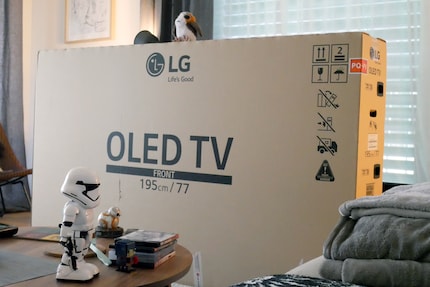
News + Trends
LG’s new OLED TVs hit the shelves in June – and I’ve already seen them
by Luca Fontana

LG's OLED TV has me excited. And not just when I'm feeding the screen with UHD content. Thanks to the new processor, even lower resolution content looks great. Not to mention the great sound. The 77-inch C8 screen is looking for perfection, and it's found it.
Recently, I checked out LG's 2018 line-up of new OLED TVs. Among them: the 2018 OLED C8 model.
Nothing and no one could have stopped me from testing it. With no hope of success, I dared and, with great boldness, asked LG's key account manager:
"Can I take it?"
His reply:
"No. There's too much risk of it breaking in transit."
That's true.
It's true that a "yes" would have surprised me. But then he goes on:
"What if we had it delivered to your home?"
I'm sitting on my sofa, in front of me, a cardboard monster. That's right what, he really is huge. What does that mean?
Thankfully, I'm not alone. Two LG technicians kindly set about removing this mountain of cardboard. Then they put the TV on the chest of drawers and switched it on. With the cardboard packaging gone, what's left is this marvel with a 77-inch picture diagonal, or 195.58 centimetres.
You're wondering why I'm testing the device at home?
The test begins.
The test begins.
First, I just want to turn the device on and leave it running. Like most buyers who don't want to spend hours with contrast, sharpness and other image optimisation settings. Although, some people like it without admitting it. I'm testing the C8 as if it were me and not the technicians who had taken it straight out of the box and switched it on without waiting. In our jargon, we also call this 'out of the box'.
I turn on Netflix and choose the series "Lost in Space". Like most of the Netflix originals, it's available in UHD resolution and offers Dolby Vision, the more advanced version compared to the usual HDR10 format.
I turn on Netflix and choose the series "Lost in Space".
The series begins with the searing crash of the Robinson family spaceship. I revel in the perfect black levels of the universe, where I discover every last detail on the spaceship's hull thanks to the gigantic contrast. Fiery red flames sparkle as the ship careens out of control into the atmosphere of the blue-hued planet. The family crashes noisily into the supposedly icy planet. Thanks to the most filigree gradations of white, I recognise every hill and snowflake.
Will Robinson, the youngest of the family, wears the same stunned look on his surroundings as I do on the C8.
Later, I give "The Grand Tour" a try, just to see how the TV reacts when the general colour temperature becomes warmer and more pleasant than for the sci-fi epic. That aside, there's a lot of smooth panning with cars speeding past.
Wow. What I'm seeing is almost perfect.
The colours in the car geek series are simply outstanding, at every turn they look natural and never artificial. The cars speed past without leaving any streaks or kinetic blurs. Whatever content I'm looking at, the image always conveys a certain 'momentum' to me. And although I'm sitting quite close to the screen, at around 3.20 metres, I'm not discovering a single pixel. UHD resolution, then, 3840×2160 pixels, that's 'top'.
By the way: UHD and 4K, what exactly are they? The term "4K" comes from the cinema industry and is commonly used for TV sets too, although in this field it's not technically correct. If you hear talk of a 4K television set in the industry, you are in fact "only" looking at UHD resolution. In this article, I won't use 4K as a synonym. I'm resolutely sticking with the technical term "UHD".
That UHD content looks stunning on the C8 with or without HDR support is no surprise. And what about beyond ultra-high resolution images? Here too, everything goes very smoothly thanks to the new Alpha 9 processor. Incidentally, the processor is one of the most important components of a TV set - it's the brain, so to speak.
But one thing after another. What is the primary task of processors?
For the C8, things improve significantly. Here, it's the processor that handles everything. It effectively reduces digital noise without being overzealous. So: at all times, the image looks natural and not reworked. In fast-moving action scenes, unpleasant artefacts are eliminated. Contours are smoothed out later in the interests of sharpness to make the image look sharper.
But also beyond the streaming portals, for example, when I display streaming YouTube content on the TV (which you really should try, if you don't already) or when I watch live TV, I find nothing but rave reviews: colours are harmonious and unpleasant streaks when panning smoothly are eliminated.
Mostly while watching football I tried to detect the jerks and streaks. Nothing of the sort. This argues for a good TV response time. Of course, I played Fifa online: even in video game mode, the picture remained absolutely consistent. As far as UHD gaming is concerned, according to external reports, the input lag is just 21 milliseconds. That's a very good value and Sergio Ramos' killer tackle will still look good.
Ah yes: the WebOS operating system is updated to version 4.0. Don't expect a quantum leap compared to WebOS 3.5, but a Smart-TV that's easy to use and, as always, runs smoothly, with all the important apps like Netlix, YouTube or Zattoo.
I really like my Sonos Playbar. It boasts incredibly balanced dynamics in big action scenes. I've rarely noticed the bass coming through so nicely, without dominating the sound itself.
I admit that right now, LG's C8 is making me a little sick to my stomach. Not because the sound is shoddy. But because the sound is almost as good as on my soundbar. I can hear myself muttering into my beard that I don't have: "This is outrageous, no TV speaker on this planet should compete with my 700-franc soundbar!"
It's true that in the end the sound doesn't fill the room as much as the sound coming out of my soundbar. Nor does the sound image seem to be at its best, particularly when playing music. And yet, the C8's performance deserves a great deal of respect. Bass vibrates nicely, even if it's not too dominant. Vocals remain clear and background noise fills the space adequately.
The speakers are made up of a 2.2 audio system with 40-watt amplifiers. Despite the thinness of the OLED, they work surprisingly well. To make it more understandable, I'll go a little deeper.
A speaker generates sound by moving air: the bigger the driver, the more air it can move and the better the sound. It's true that the TV box of an OLED TV is in principle extremely thin since there are no background LEDs, because the pixels of OLEDs are organic and shine on their own. This saves space. This makes it difficult to integrate speakers into the casing that are large enough to generate decent sound.
I give "Lost in Space" another try, as Netflix offers the series with a Dolby Atmos audio track. I watch a few more action scenes and then a few quieter scenes.
The main new feature from LG is the Alpha 9 processor: with this, not only are UHD HDR images a feast for the eyes, but it also guarantees highly efficient scaling of conventional Full HD material, without losing the natural look of the image.
A few words about the screen size. At first, I was rather impressed. All the same, the image diagonal is large; just over 195 centimetres, about ten centimetres longer than me. The idea that I could sprawl diagonally across my TV both amuses and frightens me at the same time.
Three weeks later. I've long since got used to 77-inch TVs. And so has my girlfriend. The C8 is practically part of the family. I keep asking myself the same question: would I still be able to look at the screen of a normal-sized television without becoming claustrophobic?
I'm going to have to find a way of getting used to it.
I'm going to have to find the answer, whether I like it or not. The OLED is ready for transport, and we've come full circle. Porgi breathes in the fresh mountain air one last time.
I write about technology as if it were cinema, and about films as if they were real life. Between bits and blockbusters, I’m after stories that move people, not just generate clicks. And yes – sometimes I listen to film scores louder than I probably should.
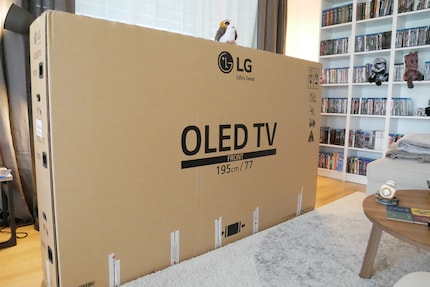
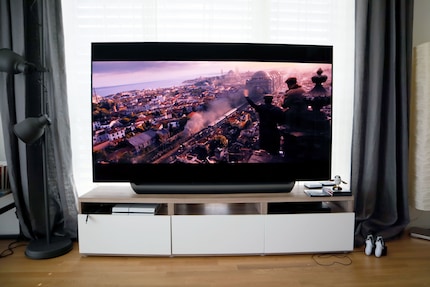
Many TV tests are carried out under laboratory conditions. So: in perfectly darkened rooms, always under the same conditions. But what's the point? The TV's place is at home, not in a lab. I'd like to test the device with my own films, games and sporting events, and not just with content that is 100% TV-friendly. Sometimes the sun shines brightly, sometimes not. When I'm having a movie night, I draw all the curtains, but the conditions aren't the same when I'm watching a football match on a weekend afternoon.
.
That's why LG's brand new OLED TV now takes pride of place in my living room. In all its giant glory.
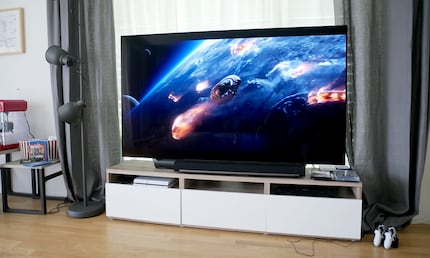
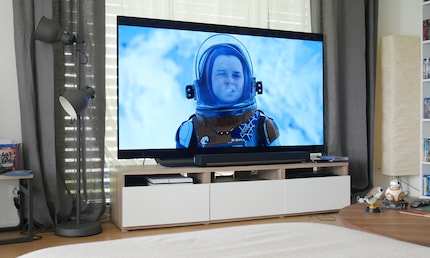
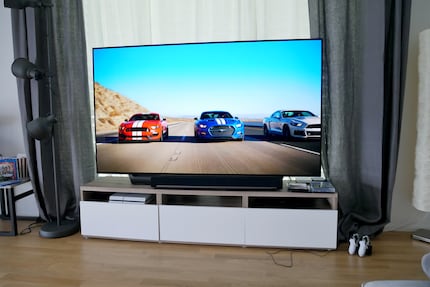
As you can see from the photos, I didn't make it easy for the TV in terms of clarity. Behind my TV, the window shutters are down "by default". I wouldn't want anyone to be able to see the 'back' of my treasure. But on the left-hand side, there's a lot of natural light coming into the living room, so the conditions aren't necessarily ideal. The image comes out very well, with reflections barely visible. This argues in favour of good brightness values.
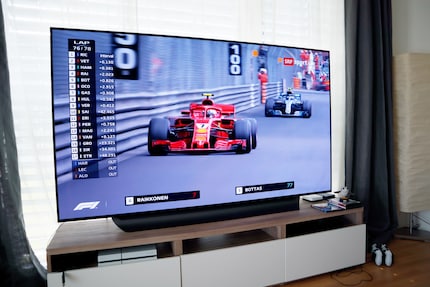
Image processors are primarily used to calculate and enhance video signals from the tuner or video inputs, such as HDMI ports. When you watch a film streaming, the signal arrives most of the time in Full HD resolution. But you have a UHD TV. The TV processor then scales the content to UHD resolution, eliminating annoying digital noise, smoothing edges and enhancing colours. Of course, the processor does the same for all sources, including UHD and HDR material, but to a different extent. The more powerful the processor, the more visible the final result. So yes, the Alpha 9 processor is powerful.
I see this especially with the series "The Walking Dead", which Netflix only makes available in Full HD. On my old TV, the picture is so full of digital noise that I often wonder if Netflix only had as its source.SD quality (Standard Definition, in other words, what there was before Full HD) and that all that was done afterwards was a vulgar scaling. In fact, I might as well be watching a classic DVD.
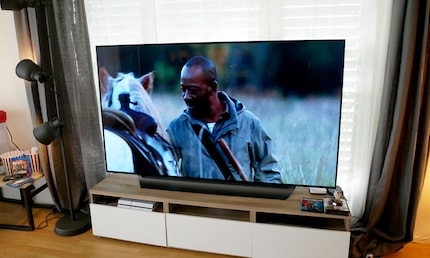
If I wanted, I could even activate HDR mode in the image settings. As a result, the basic red, green and blue colours are a little more saturated than usual, plus the OLED makes the picture elements clear with more intensity. The result seems a little artificial to me. Incidentally, this is also the case for other equipment, regardless of resolution. That's why I almost never use HDR mode. But still, I couldn't have imagined that you could get so much performance from such a weak source. Sony AF8, now that's a competitor to take seriously.
The reason for this excellent sound is Dolby Atmos. The ultra-modern audio format is actually supported by all of LG's OLEDs. I've tried to capture this in the video above. Of course, the video can't reproduce 100% of the feeling you get when you listen to the OLED TV speakers live. But you'll still be able to get a good idea.
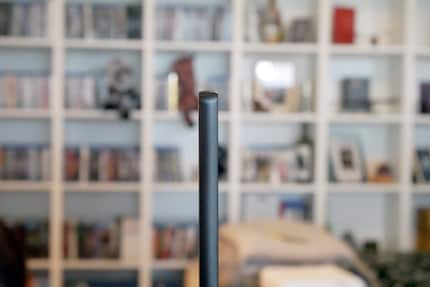
LG can't change physics. But give it a little help. That's the role of the support leg, dubbed the 'streamlined Alpine stand' by the Seoul-based manufacturer. Not only is it elegant, it also serves a very specific purpose: the television's speakers face downwards and, thanks to its shape, the stand directs the sound directly forward towards the viewer. This generates a wider soundstage that is superior to that of conventional TV speakers. No wonder the C8 delivers a sound that fills the space well.
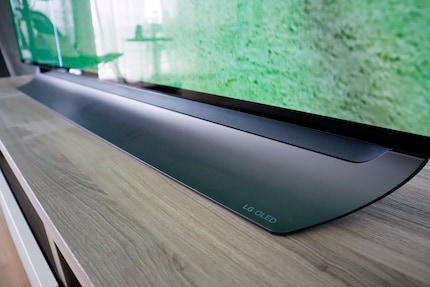
I'm still impressed, but honestly I don't notice any real difference from "The Grand Tour" which only works in Dolby Surround mode. Is the space filled? Yes. The bass is decent. But a sound that comes from the ceiling, as is common with Atmos? I don't notice any of that. Perhaps the space adventure series is poorly mixed, and there isn't enough Dolby Atmos equipment to do large-scale testing.
.
Maybe it's physics again that limits internal TV speakers.
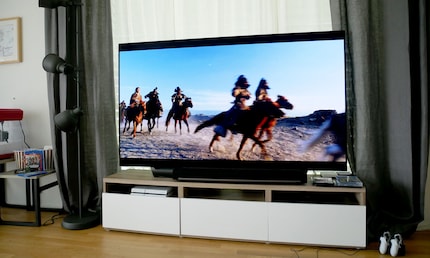
It doesn't matter how many inches you want in your living room: the LG C8 combines the most spectacular picture I've ever seen with an aesthetically pleasing kickstand design and sound that's unrivalled in this field. In terms of a comparable quality sound experience, only in terms of internal speakers, I could only cite Sony OLED A1 or its successor AF8.
